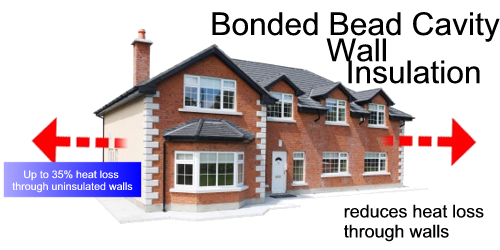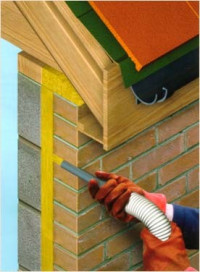Cavity Wall Insulation
Cavity Wall Insulation for Energy Efficiency
Cavity wall insulation (CWI) is widely regarded as the most efficient method of improving a property's energy efficiency as, without insulation, homes lose up to 35% of their heat through the walls.Bonded Bead Cavity Wall Insulation
Our bonded bead cavity wall insulation meets the highest technical specifications and is fully warranted by all Irish trade associations. Our product offers a complete fill, with no gaps and consistent density across the cavity, ensuring effective heat retention.Benefits of Bonded Bead Cavity Wall Insulation
- Lowers fuel bills - with annual savings of up to €300
- Reduces carbon emissions
- Our bead product is fire resistant and waterproof
- The bonded finish permits water to travel down the cavity - without crossing it - ensuring no damp or thermal bridging
- Suitable for installation in all areas including where there is bad weather and heavy rain
- Ensures a comfortably warm home all year round and dry inner walls
- Fast clean install- all equipment is brought and taken away by installers
- Quick installation - the process takes just a couple of hours
Why Cavity Wall Installation
The majority of homes have been built with cavity walls to prevent rainwater penetration causing dampness.An empty cavity wall allows air movement through the cavity, cooling down the inner walls as outside temperatures drop. Filling the cavity with water repellent bonded beads reduces insulates against this temperature drop, keeping your home warmer.
Watch Our Blown Bead Video
Bonded Bead Installation Process
Pre-Installation
Before installation we conduct an inspection to determine the quality of any existing insulation and ensure the cavity is suitable or clean.The Installation Process
- Drill Holes: we drill holes of 22mm diameter across the wall - using the correct drill pattern in conformance with building regulation guidelines.
- Delivering the beads: Our delivery gun is inserted into the drill holes and the Energystore Graphite 27 Plus bead is blown into the cavity along with a liquid adhesive.
- Filling the Cavity: The free flowing nature of the bead ensures all gaps are filled while the use of an adhesive ensures the bead sets into a bonded homogenous material.
- Finish: all holes are filled and finished.
Rockwool Cavity Wall Insulation
EnergySaver blown cavity wall insulation for existing and new constructions
Rockwool EnergySaver cavity wall insulation is an entirely dry system which uses granulated Rockwool blown into an external wall cavity to a predetermined density. No glues or catalysts are involved in the installation procedure. The system may be used to improve the thermal insulation of both new and existing masonry cavity walls as well as certain types of non-traditional structures. Rockwool EnergySaver blown cavity wool does not create a bridge or capillary path within the cavity that might allow rainwater to penetrate to the inner leafAdvantages of EnergySaver Blown Cavity Wall Insulation
- Ensures a complete fill without settlement
- Water repellent will not allow water to migrate across cavity
- Vapour permeable allows construction to breathe, reducing condensation risk
- Irish Agrément Board certification
- Cost effective solution
- Non-combustible (Euroclass A1)
- No wastage
- Minimises thermal bridging
- Improves fireproofing and soundproofing
- Installation by approved Rockwool and NSAI installers
Standards and approvals
- British Standards: BS EN 13162:2001 Thermal insulation products for buildings- Factory made mineral wool products-specification.
- EnergySaver has been examined by the Irish Agrément Board and certified for use in all exposure zones. The assessment is covered by Agrément certificate No. 05/0222.
Building Regulations
- HP EnergySaver when injected into a cavity can help bring the U-value of the wall in line with current TGDL requirements and is also accepted as a solution under the HES (Home Energy Savings) scheme.
- HP Energysaver blown cavity insulation can only be installed by qualified approved installers. Always check with Rockwool that a supplier or installer is an approved installer, they will welcome this check.
- Phone Eire: +353 1 8911 055
Sustainability
Relying on entrapped air for its thermal properties, Rockwool insulation does not contain (and has never contained) gases that have Ozone Depleting Potential (ODP) or Global Warming Potential (GWP). Rockwool therefore complies with the relatively modest threshold of GWP<5 included in documents such as the Code for Sustainable Homes.Rockwool Ltd is increasingly involved in recycling waste Rockwool material that may be generated during installation or at end of life disposal, and has a recycling scheme that is recognised by WRAP and the Environment Agency.
We are happy to discuss the individual requirements of contractors and users considering returning Rockwool materials to our factory for recycling.BRE A+ rating
Fire performance
- HP Energysaver blown cavity insulation achieves an A1 classification in accordance with BS EN 13501-1 and is therefore non-combustible as defined in UK and Ireland building regulations.
- The melting point of Rockwool is above 1000°C. It is therefore ideal in circumstances where protection against spread of fire is required in addition to insulation.
Durability
- HP EnergySaver blown cavity insulation is a durable material.
- EnergySaver has been proved in service for over 40 years in all types of climate and degrees of exposure. It will give effective protection for the lifetime of the building.
- HP EnergySaver blown cavity insulation is a completely inert, rot-proof material and does not encourage the growth of fungi, moulds and bacteria or offer sustenance to vermin.
Water resistance
EnergySaver repels water due to the presence of water repellent additives. Should water penetrate the outer leaf of the cavity wall, it will drain down between the wall surface and the injected filling. The Rockwool EnergySaver system is designed so that water will not cross the cavity by capillary action. In situations where Rockwool material is present both above and below the ground floor damp-proof course, it will not transmit ground water by capillary action.Condensation control
- When calculating vapour diffusion through a structure, the vapour resistance of Rockwool is negligible and is usually considered to be the same as for air.
- Moisture condensing from the air within Rockwool material is less than 0.02% by volume at 95% relative humidity.
- EnergySaver therefore reduces the risk of condensation and allows natural drying out of the wall construction due to its ability to breathe.
- Where condensation and black-spot mould have occurred on inner walls of occupied buildings, EnergySaver will assist in the reduction of this problem, provided that heating and ventilation are adequate and the situation is not as a result of a cold bridge.
Compatibility
EnergySaver will not react with wire, plastic or metal wall ties, brickwork or masonry, nor will it cause loss of plasticiser from PVC cables and pipes.Contact Us for cavity wall insulation throughout Munster and Leinster, including counties: Laois, Tipperary, Offaly, Kilkenny, Kildare, Carlow, Westmeath and Dublin, Ireland.



